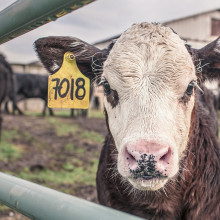Synchronised brains, and bird flu spreading in cow's milk
In this edition of The Naked Scientists: A meeting of minds: scientists show that when two people talk, their brains really do sync up. Also, bird flu is now spreading among cattle via their milk. What are the implications? And, a new scientific twist for better, more efficient fog harvesting to keep arid areas watered...
In this episode

01:05 - Brain waves sync up when two people talk
Brain waves sync up when two people talk
Sam Nastase, Princeton University
You’ve probably heard people talk about “being on the same wavelength” as each other, and we tend to use phrases like, “I get what you mean,” when we’re explaining things to one another. And, as an intriguing experiment has shown this week, it turns out that, when we really do “get” what the other person is saying, we’re syncing up our brain activity with theirs! Sam Nastase, who is at Princeton, had the opportunity to work with two patients undergoing surgery for epilepsy for which they had received brain monitoring implants ahead of their treatment. He put the two of them together so they could converse, while their patterns of brain activity and what they actually said to one another were recorded in real time. And by using AI to analyse the words and contexts of what they said, and relating this to the brain recordings, it was possible to show identical patterns appearing in the brain of the listener and the speaker…
Sam - We were lucky enough to have two epilepsy patients in the room together at the same time. Right. Both of the patients have electrode grids placed directly on the surface of their brains that is basically recording electrical activity as the neurons in their brains are firing while they're having a face-to-face conversation with each other. So we get neural activity measurements in both brains at the same time. We're recording all of the audio in the room so we know exactly what they're saying when we can describe that. And that's kind of where we start in terms of modelling.
Chris - So what, to my naive mind, you are doing is asking, when one person outputs some data, we can look at what the pattern of brain activity is. Then we can look at the recipient of that data and we can see if their brain basically recapitulates the pattern of activity that came out of the first person's brain arguing. They are definitely on the same wavelengths of each other. You've recreated the same neurological pattern in the recipient as the emitter.
Sam - That's exactly right. And in the past we've tried to do something like this directly. Where we look at how correlated is my brain activity with your brain activity. That's interesting, right? Because it can really tell us like, how closely are two people coupled? How strongly correlated are they? It can tell you maybe where in the brain there's brain to brain coupling. But it doesn't really tell you what the content of that coupling is. It doesn't tell you what information in my brain is driving brain activity in your head. And so that's where we try to bring in explicit models of linguistic content, right? Because a conversation could be driven by all sorts of things. Like you know, gestures and facial expressions and things like this, right? We don't really know what's driving the brain to brain coupling. So we're going to bring in models, we're going to test different models to see what information is really shared between the two brains.
Chris - And how do you analyse the speech, then, to work out what the content is in order to then ask how that relates to the brain activity. Because that's the nub of what you're saying to me is it's what is the content and what elements of the content and in what context they're being presented between the two that is then producing this kind of resonance in the other one's head.
Sam - Yeah. So we start with the transcript and we're going to feed these words into different kinds of language models, right? And we had hypothesised that this new generation of large language models will best fit the human brain activity. Because these models really capture the meaning of words in context.
Chris - So unlike where we might have a problem, if I said to you, you were cold, I could mean you are thermally challenged. On the other hand, I could mean you're extremely unforthcoming in this interview <laugh>. And unless I know the context and you know the context, then actually a model wouldn't know. So that's what you're trying to say. You're trying to extract a lot more information about the words which will make your interpretation, I suppose, a lot more accurate.
Sam - Yeah, that's right. Models like GPT can really sculpt the meaning of each word as you're going through a conversation and represent that word in a much more specific context sensitive way.
Chris - So when you do this, what do you actually see then once you start subjecting the brain activity patterns to this sort of scrutiny with this very tight interpretation, much more accurate now of the context of the words being used by the speaker and the receiver. What emerges?
Sam - Yeah, so we use these rich context sensitive representations from a model like GPT and we're going to run these representations up against the brain data. We can see this really beautiful dynamic where just prior to each word, word by word, as I'm speaking like this. Just prior to each word, the model can capture linguistic content starting to emerge in my brain activity prior to the articulation of the word. And then as soon as I say the word, we can see that same linguistic content reemerging in your brain as you hear the word. And as you process the meaning of it.
Chris - If you mix up people from different cultures, backgrounds, linguistic backgrounds, would you get a different result here? Because there's this old saying, isn't there lost in translation? I presume the people here were from the same sort of cultural and linguistic background. So this sort of synergy occurs. But would you expect a difference if I put someone from the other side of the world who didn't naturally speak English, it was their second language in the room?
Sam - Yeah, absolutely. If you have, for example, a non-native English speaker who's not particularly proficient in English, right? I think that using this kind of modelling approach, you would be able to see that their brain is not as easily keeping up with your brain or they might have to do more neural work to keep up with your brain in a way that might be much more sort of easy for a native speaker.
Chris - I presume the two people who were chatting got on okay. What would happen if they disagreed? What about if you started a row between them <laugh>? Would you start to see them reacting quite differently? Because obviously one's brain is syncing up with the other because they like each other, they're agreeing with each other. What about if they fell out?
Sam - I don't think we have particularly good examples of that in this relatively limited set of conversations, but you can certainly imagine scenarios where we are not aligning, right? Like our brain activity is not aligning. Or maybe, maybe I'm trying to kind of push you in a particular direction, or maybe I'm even trying to deceive you or something like this, right? There are a lot of interesting scenarios where alignment is not really the only goal. We're not really able to look at that with the data that we have. But I think it's a really interesting question.

07:45 - H5N1 Bird flu spreading through cow's milk
H5N1 Bird flu spreading through cow's milk
Wendy Barclay, Imperial College London
Governments and scientists internationally are becoming increasingly alarmed by the the threat posed by the H5N1 strain of bird flu. What’s got people worried is that, having produced the largest outbreak of bird infections yet documented over the last few years, the virus has now spread from birds into mammals, including in the US into farm animals like cows; and in them, it’s evolved the ability to maintain sustained infections over several months, spreading from animal to animal. Apart from bringing the infection a step closer to us, it’s also adopted a completely novel mode of spread, via milk and milking machines. And farm cats that have come into contact with the milk have died. Consequently many countries have quietly notched up their risk assessments of the threat of a human H5N1 pandemic. In the UK, disease experts say we’re sitting at position 4 on the 7 point scale. Virologist Wendy Barclay is based at Imperial College London…
Wendy - Since about 1997, this particular bird flu known as H5N1, which is what we call a highly pathogenic avian influenza virus. There was a lot of fuss about it in the early two thousands when it caused a lot of disease both in birds and in humans. This particular H5N1 has continued to evolve in two different ways. It mutates a little bit and it also reasserts shuffles up its genes with the genes of other bird flu viruses. And since around about 2020, a derivative of that bird flu H5N1 from back in 1997 and the early 2000s has reemerged as a very vigorous virus, and it has spread all the way across Asia, Europe, and now across into the Americas, which is pretty much unheard of for bird flus until now. They've tended to sort of at least stay in two groups, the Eurasian viruses and the American ones. But this one has caused what we call a panzootic, which basically means it's a disease of animals and it's just everywhere.
Chris - What about into non bird populations? Because that's the other thing that's beginning to surface. We are seeing reports of other animals that are also being diagnosed with this. Where are they getting it from?
Wendy - Well, absolutely. So, what we've seen is that there's been so much of this particular H5N1 in the wild birds and they have been dying, that we've started to see cases cropping up in some wild mammals, seals and sea lions that scavenge on dead sea birds. We've also seen it in foxes and otters. Also into farmed mammals, for example mink being farmed for their fur in Scandinavia, Denmark, Finland. And also certain breeds of arctic fox, for example, which are also farmed for their fur. And then finally we get to 2024 where I think we were all quite surprised to hear that now this same H5N1 virus has found its way into dairy cattle.
Chris - Is there any evidence when it gets into these non avian, in other words, non bird species, that it's actually transmitting? Or are they just being exposed to so much virus when they find a dead bird or come into contact with one in their environment that there's almost an inevitability they're going to pick it up like the humans you mentioned earlier?
Wendy - It's very difficult to say for sure that we're seeing mammalian to mammalian transmission, but the outbreaks that have occurred in seal colonies down in the South Americas, for example Georgia and the Falkland Islands, do look as if we're starting to see some transmission. Some of the outbreaks in farmed mink look as if there could be some transmission. What's really important when we start seeing mammalian to mammalian transmission is to ask whether or not the virus is mutating in a way that is enhancing the transmissibility of the virus, not only between those mammalian species, but also with the potential to enhance airborne transmission between humans. Thankfully, we haven't yet seen mutations associated with the mammalian transmission events, which lead us to think that that has happened.
Chris - Because we have seen some human cases. So how is it then that it can infect an animal including a human, but not transmit between those species?
Wendy - I'd certainly say that the human cases that have been reported so far look as if they've been directly acquired from birds or contact mammals to which the people have had significant exposure. Receiving either a large dose or a dose under a circumstance where that kind of transmission could happen. But no further mutation within the person to drive human to human airborne transmission. The cattle is quite an unusual story. There's this very unusual situation going on in the United States where most of the transmission is through the milking machinery. The virus has found a niche in the mammary glands of these cows. It's replicating to very high titres there. And then if traces of milk contaminated with virus are left behind on milking machinery and that's not adequately cleaned before the next cow is milked, it seems that there's some level of mechanical transmission of the virus from one cow to another.
Chris - If it did, heaven forbid, because it spent so long in mammals, it would adapt better to get into the farmer as well as the animals the farmer keeps. Could we end up with a disease that could transmit via human breast milk and you'll end up with mothers infecting their babies?
Wendy - That's a very interesting question. I mean, certainly some of the animal studies that are being published now on the H5N1 shows, this isn't unique to a cow's. Laboratory mice have been fed contaminated milk and they indeed become infected through that route and lactating mice can pass the virus onto their pups through the milk. So I wouldn't exclude that there could be a derivative of, of a virus that could be passed from mother to child through the milk.

Twisted fibres boost efficiency of water harvesting from fog
Andreas Carlson, University of Oslo
Fog harvesting is a simple method of collecting fresh water from the air. You string up a mesh material, and water droplets form around the threads and run down to a receptacle. But now a bit of maths and a handful of experiments have shown that we can probably improve enormously on the efficiency of this system. The same science might also give us better microfluidic devices, and even clothes that dry themselves much more efficiently. University of Oslo mathematician Andreas Carlson has discovered that if two threads are twisted together, at the point where the two meet a gully is formed. When water droplets form on such a twisted pair, unlike with a single thread where they tend to get stuck and don’t go into your collecting tin, the droplets are guided into the gully and gravity rapidly pulls them down the thread. He reckons this simple alteration could boost the water output of fog harvesting systems, which can be a lifeline in arid places, by at least a fifth…
Andreas - There has been this concept called the fog nets, which is essentially like a fishing net that you string up. And fog is just very, very small droplets that are dense and they collide with these nets. They drain off and you get water. And what really intrigued us is can we rethink a little bit how we can design this to get better yield when extracting water from the atmosphere?
Chris - Can we start Andreas by thinking about just the single threads that are in those, you dub them, fog nets or fishing net-like structures. When a droplet of water lands on that single thread, what does it do
Andreas - When you have these droplets that kind of collide with the thread. What happens is that you form a drop that most of the time actually gets quite stuck because it cannot just move because there is some roughness on the surface that kind of doesn't really allow the gravity to pull the droplet down along the tread, which then kind of limits their efficiency.
Chris - So if you look at such a thread, you would see the water sort of circumferentially, the droplet would wrap itself around the thread and effectively just lodge there, sticking to the thread.
Andreas - Exactly. So if you have this nylon or plastic threads, what you then get is the water that would cling entirely around the tread, and it would grow so it would become actually quite big. And as it grows big, unfortunately what happens is that the efficiency of these nets go down. So you would like to have these small droplets collide with the net and be very quickly and effectively kind of drain through the net.
Chris - So all the time there's droplets stuck on the net. They're not running into your receptacle giving you fresh water. They're sticking to the net and that's harming the efficiency. So the challenge then is, well, can we make these structures any better at channelling those droplets off of the net and into our pipe?
Andreas - Yeah. There, so there are three things. One, you, you would like to have a very quick drainage and you would like to avoid large droplets because they reduce efficiency in the sense that they can get retrained by the wind. So they just get pulled off the net. And also it turns out that you would like to have rather a lot of small droplet instead of just some larger ones on this net because then the efficiency effectively goes down
Chris - And now you're going to tell me how you think you can do it. So what do you think you've got here? What have you discovered?
Andreas - What we discovered is that if we now generate a groove, which we can then easily do by putting two fibres together, similar to a structure of ropes, which then allowed us to transport water and droplets along this kind of groove structure as we twisted the fibres together.
Chris - Got you. So if I imagine my index finger and then the next finger to it stuck together and that there is a crease between the two by winding two threads together, you create that groove and the droplet falls in there rather than forming that almost barrel shaped circumferential droplet round the single thread.
Andreas - Yes. And really the fascinating part with that is that we can then show that you can then entirely control which shape the droplet would take and also how it would move about as it kind of pulls down by gravity. If you put one droplet on these twisted structures.
Chris - It's a bit like a helter skelter that you see at the fairground then, isn't it? Where the slide goes down, the droplet is effectively in the slide of the helter skelter. That slide being the groove created between the two coiled threads as they wind around each other. How does the size of the threads and also the frequency or the rate at which they're twisting make a difference. Because you could have a helter skelter with lots of twists of the slide or a very shallow twist to the slide. So what's the optimum?
Andreas - This really depends on your kind of application. So if one wants to think about harvesting water from there, we saw that the more we twist the better it is. So the more winds your helter skelter has, the better it would be.
Chris - And what sort of impact do you think this would make if you took fog harvesting, this is where we started and you said your aim was to try to understand and then improve on that. How much better is the water harvesting potential, the efficiency? If you put this twisted configuration into play, what sort of improvement can you achieve, do you think?
Andreas - What we did in our article is that we really illustrated that this is a concept that has a potential to work. Our next step is now of course to kind of explore this in a wider range of wind and fog conditions because I think this is kind of the first proof of principle. But what our results indicate is that we can have a significant improvement if you compare with the single fibre. So at least probably around 20% or more.

21:15 - Covid-19 vaccines not linked to heart attack or stroke risk
Covid-19 vaccines not linked to heart attack or stroke risk
Samantha Ip, University of Cambridge
The rollout of the Covid-19 vaccines saved millions of lives by turning what would otherwise be a lethal infection for some into a trivial infection for the vast majority. But there were also some concerns around potential side effects. The Astra Zeneca vaccine was linked to brain blood clots, and some speculated that the jabs might raise heart attack and stroke risks. One of the problems with studying these sorts of associations is that if the outcomes are rare, they can be hard to detect. But if you do a big study, because you have access to a literally huge population dataset, the statistical power skyrockets, and even very small differences can be detected. And that’s what Cambridge’s Sam Ip has done using “big data” collected across the pandemic by the NHS. Her findings concerning common cardiovascular complaints like heart attacks and strokes, are very reassuring…
Sam - We were very lucky to get our hands on a massive data set with 46 million adults, in fact, in England, provided by NHS England, bringing together your GP records, hospital records, Covid test and vaccination records and death data. And this allows us to study all the rare complications, common complications,
Chris - Anonymous data? All provided to you anonymously.
Sam - Yes, absolutely. They are all de-identified, provided in a secure data research environment.
Chris - Very powerful though, when you can get data at that sort of scale because presumably it helps to iron out the effects of sort of noise and the biases that creep into very small studies. You can really see the signals as they really are at a population level.
Sam - Absolutely. Firstly, it's really representative. It covers basically everyone in England and it gives us immense statistical power to study even rare conditions.
Chris - How did you actually analyse the records then? Once this comes to you, how did you then pick through it to work out what those associations were or weren't?
Sam - We looked at the data. We found out, for example, when they had their vaccinations, whether and when they had their heart problems as well as identified various other factors that could affect these associations and give you wrong answers. And we then put them all in a model that then gives us some sort of association.
Chris - And what trend emerges? Is there a link between being vaccinated or not and these health outcomes you're interested in?
Sam - Yes, there are. The main result actually is quite reassuring, which is that for common conditions, for example heart attacks and strokes and so on, the rate of these happening is actually similar or lower after people got their Covid vaccinations. So that's actually really reassuring and we, as for the rare complications that were previously reported and regulators and medical professionals are looking out for, those our study also corroborated these findings.
Chris - So that would be things like the claim that the AstraZeneca vaccine was linked to an increased risk of blood clots in the brain, for example, in certain groups. That, you saw that.
Sam - Yes, yes. But they are very transient. These effects only lasted for a very short period of time.
Chris - The fact that the rate of heart attacks and strokes and so on was lower or the same in people when they were vaccinated. To what extent could it be that the vaccine was preventing them catching Covid? Because one of the suggestions was that you catch Covid and it makes your blood stickier, it makes you have a higher risk of these sorts of outcomes. Could that be that mechanism?
Sam - This is a brilliant hypothesis and it is something that we also hypothesise that it might be true, but this is not the focus of this particular study. We're just trying to establish the links and associations between vaccinations and heart problems. But yes, this is very plausible and it's definitely worth looking at more.

25:39 - What is the Universe expanding into?
What is the Universe expanding into?
James - The Big Bang theory describes the universe's origins from an initial state of incredibly high temperature and density and its subsequent expansion. We think it's a good theory because it explains some of the features of the universe that astronomers have observed over the years, such as cosmic background radiation. And next week we'll have a special interview with Nobel Prize winner in physics, Brian Schmidt, who proved that the expansion of the universe is speeding up rather than slowing down. Stay tuned for that one. But you raise an interesting point, Anne. If the universe is by definition all that there is, as Paul writes on our forum, then nothing can exist outside of it for matter to be expanding into. Luckily, the University of Cambridge's public astronomer Matt Bothwell, is here to explain.
Matt - Unfortunately the answer is slightly counterintuitive. When we think of the universe expanding, we might think of a balloon being blown up or a cake or a loaf of bread rising in the oven. These are the metaphors we often use and it's good in one sense. We can think of a cake rising and it's an object that's expanding a bit like the universe, but it breaks down because outside the cake, there is the space of the oven. And as the cake gets bigger, it gets bigger and bigger into the oven. So what's outside the universe for it to be expanding into? And the answer really is that it's not expanding into anything. I think the trick is to not think of space and time as like a box the universe is in, but think of space and time as properties of the universe. When the universe is expanding, it makes space as it grows, but there's no space outside the universe that it grows into. It makes more space from the inside. So the universe itself is getting bigger, but there is no outside of the universe for it to get bigger into.
James - Halc builds on this point on our forum when they write the expansion of the universe is the metric expansion of space itself. Meaning that each volume of space is later larger. The universe was always infinite, never bounded, and has no centre, no edge. Thanks Halc. So Matt, if the likeness to a cake in an oven isn't satisfactory, are there any other useful comparisons we can use?
Matt - A nice analogy that you might like is to think of the number line. So the line of numbers that you learn in maths in school, you know, 1, 2, 3, 4, 5. If you take that number line and multiply the whole thing by two, you end up with 2, 4, 6, 8, 10. We've expanded the number line, but it's not expanded into anything. Just the spaces between the numbers have grown, just like the space between the galaxies is growing in our universe.
James - Thanks, Matt. I hope that somewhat cleared things up for you, Anne. Thanks for the great question and to Matt Bothwell from the University of Cambridge for helping us with the answer.










Comments
Add a comment